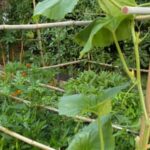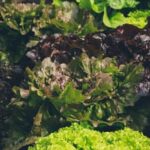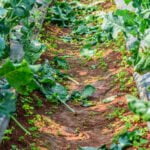Dyed mulch has gained popularity in landscaping for its vibrant colors and ability to enhance the visual appeal of garden beds. However, when it comes to using dyed mulch in vegetable gardens, there are concerns regarding its safety and potential impact on plant health. In this article, we will delve into the basics of dyed mulch and explore whether it can be safely used in vegetable gardens.
Before we analyze the compatibility of dyed mulch with vegetable gardens, let’s first understand what exactly dyed mulch is. Dyed mulch is typically made from shredded or chipped wood that is then tinted with pigments to achieve various shades such as red, black, or brown.
Vegetable gardens, on the other hand, are areas where edible plants are grown for personal consumption. Mulching plays a crucial role in vegetable gardening as it helps regulate temperature, retain moisture, suppress weeds, and improve soil health.
The science behind dyed mulch raises questions about its composition and potential risks for vegetables. The ingredients used in dyeing mulch can vary but often include iron oxide-based pigments and biocides to prevent mold growth. It is essential to understand how these additives may affect the nutrient content of the soil and subsequently impact plant growth. Additionally, certain chemicals present in dyed mulch could leach into the soil over time.
In the following sections of this article, we will delve deeper into the science behind dyed mulch, explore alternative options for vegetable gardeners seeking safer alternatives, and seek insights from experts to help readers make an informed decision about using dyed mulch in their own vegetable gardens.
The Science Behind Dyed Mulch
Dyed mulch has gained popularity in landscaping due to its vibrant colors and ability to enhance the aesthetics of outdoor spaces. However, when it comes to vegetable gardens, it is important to understand the science behind dyed mulch and consider its potential risks.
Dyed mulch is made by taking natural wood chips or shredded bark and applying colorants, typically iron oxide-based dyes, onto the surface of the material. These colorants can vary in composition and may include other ingredients such as water-soluble salts, herbicides, or fungicides. While they are generally considered safe for decorative purposes, there are concerns about their potential effects on vegetables.
One of the main risks associated with using dyed mulch in vegetable gardens is the possible leaching of harmful chemicals into the soil. The colorants used in dyed mulch can break down over time when exposed to sunlight and weathering, potentially releasing these chemicals into the soil. This can lead to contamination of crops and impact their health and quality.
To better understand the potential risks, a study conducted by the University of Florida analyzed several types of dyed mulch and found low levels of heavy metals such as chromium, copper, and arsenic in some samples. While these levels were generally well below safety limits set for human consumption, it is still important to exercise caution when using dyed mulch in close proximity to edible plants.
Overall, while dyed mulch can add visual appeal to vegetable gardens, it is essential for gardeners to consider the composition and potential risks before incorporating it into their planting beds. Conducting a soil test before applying dyed mulch can help assess any existing nutrient imbalances or pH issues that might be exacerbated by its use.
Additionally, opting for safer alternatives such as organic or natural mulching materials may provide peace of mind for those concerned about potential risks associated with dyed mulch.
Table: Potential Risks of Dyed Mulch in Vegetable Gardens
| Potential Risks | Explanation |
|---|---|
| Leaching of harmful chemicals | The colorants used in dyed mulch can break down and leach potentially harmful chemicals into the soil, which can contaminate crops. |
| Possible presence of heavy metals | Studies have found low levels of heavy metals such as chromium, copper, and arsenic in some samples of dyed mulch, although generally below safety limits for human consumption. |
Benefits of Mulching
Mulching is an essential practice in vegetable gardening that offers numerous benefits for the overall health and productivity of the plants. This section will explore the advantages of mulching in vegetable gardens, shedding light on why it is crucial for successful cultivation.
Moisture Retention
One of the primary benefits of mulching in vegetable gardens is its ability to retain moisture in the soil. Mulch acts as a protective layer that prevents water evaporation, keeping the soil consistently moist. This is especially important during hot summer months when plants may suffer from drought stress. By conserving moisture, mulch ensures that vegetables have access to a steady supply of water, promoting proper growth and development.
Temperature Regulation
Another advantage of mulching is its role in regulating soil temperature. Mulch acts as an insulating barrier between the soil and external temperatures, preventing extreme fluctuations that can negatively impact plant roots. During cold weather, mulch retains warmth in the soil, providing insulation against frost damage.
In contrast, during hot weather, mulch helps to cool down the soil surface by blocking direct sunlight and reducing heat absorption. This regulation of temperature creates a more favorable environment for vegetable growth and yields.
Weed Suppression and Soil Health
Mulching plays a crucial role in suppressing weeds within vegetable gardens. The thick layer of mulch helps suppress weed germination by blocking sunlight from reaching weed seeds, inhibiting their growth. By limiting weed competition for nutrients and water, mulch allows vegetables to thrive without having to compete with unwanted plants.
Furthermore, as organic mulches break down over time, they contribute valuable organic matter to the soil. This decomposition process improves soil structure by enhancing its ability to hold water and nutrients while facilitating beneficial microbial activity. As a result, mulching promotes overall soil health within vegetable gardens.
Factors to Consider
When considering the use of dyed mulch in vegetable gardens, there are several important factors that should be taken into consideration. While dyed mulch can add a vibrant and aesthetically pleasing touch to landscaping, it is crucial to evaluate its suitability for vegetable gardens based on certain key factors. These factors include the potential impact on soil pH, nutrient levels, and overall plant health.
One of the main concerns when using dyed mulch in vegetable gardens is its effect on soil pH. Some types of colored mulch may contain ingredients that can alter the pH levels of the soil over time. This is particularly important because different vegetables thrive in different pH levels.
For example, tomatoes prefer a slightly acidic soil with a pH range between 6.0 and 6.8, while carrots prefer a more neutral pH level between 5.8 and 7.0. Therefore, it is essential to assess whether using dyed mulch could potentially disrupt the pH balance required by specific crops.
In addition to affecting soil pH, dyed mulch may also have an impact on nutrient levels within the soil. The dye used in colored mulch often contains additives that are not necessarily beneficial for plant growth and development. These additives could potentially hinder the absorption of nutrients by vegetables, leading to nutrient deficiencies over time. Proper consideration should be given to ensure that using dyed mulch will not negatively affect the availability or uptake of essential nutrients for vegetable plants.
To evaluate these potential effects on soil pH and nutrient levels, it is recommended to conduct a soil test before incorporating dyed mulch into your vegetable garden. A thorough analysis of the current state of your soil will provide valuable insights into its composition and any adjustments that may need to be made prior to using dyed mulch.
Adding necessary amendments such as lime or sulfur based on the soil test results can help maintain the optimal pH for vegetable crops and prevent nutrient imbalances.
Ultimately, before deciding to use dyed mulch in a vegetable garden, it is important to weigh the potential risks and benefits. Understanding how dyed mulch may impact soil pH, nutrient levels, and overall plant health is essential for making an informed decision. By considering these factors, gardeners can ensure that they are choosing the best mulching option for their vegetable gardens and taking appropriate measures to maintain healthy and vibrant crops.
| Factors to Consider | Evaluation of Suitability |
|---|---|
| Effect on soil pH | Potential disruption of pH balance required by certain vegetables; consideration of specific crop preferences |
| Impact on nutrient levels | Possible hindrance of nutrient absorption by vegetables; risk of nutrient deficiencies over time |
| Soil testing | Recommended to assess soil composition; adjustments such as lime or sulfur may be needed before using dyed mulch |
Precautions and Preparations
When considering the use of dyed mulch in vegetable gardens, it is important to take certain precautions and make necessary preparations to ensure safe usage. By following these guidelines, gardeners can minimize potential risks and maintain the health and productivity of their plants.
1. Conduct a Soil Test: Before using dyed mulch, it is crucial to conduct a soil test to assess the current pH levels and nutrient content of your garden soil. This will help determine whether dyed mulch is suitable for your specific vegetable garden. The test results will provide valuable insights into any necessary adjustments that need to be made before applying the mulch.
2. Adjust Soil Conditions: Based on the soil test results, adjustments may be required to optimize the pH levels or nutrient content of your soil. This can typically be achieved by incorporating organic matter such as compost or well-rotted manure into the soil. It is important to note that different vegetables have varying pH requirements; therefore, adjust the soil conditions accordingly for the specific types of vegetables you are growing.
3. Choose High-Quality Dyed Mulch: When selecting dyed mulch for your vegetable garden, it is essential to choose a high-quality product from a reputable supplier. Look for mulch that has been color-treated using non-toxic pigments derived from natural sources. These products are generally considered safer for use in vegetable gardens compared to those treated with synthetic dyes.
4. Apply Mulch Properly: To ensure safe usage of dyed mulch, it is important to apply it properly in your vegetable garden. Avoid placing dyed mulch directly against the stems or leaves of your plants, as this can potentially lead to moisture retention issues or nutrient imbalances. Instead, create a mulch barrier around the base of each plant, leaving some space around the stem to allow air circulation.
By following these precautions and preparations, gardeners can minimize potential risks associated with using dyed mulch in vegetable gardens. However, it is essential to carefully weigh the risks and benefits before making a decision. Exploring alternative mulching options that are safe for vegetable gardens may also be worth considering. Remember, maintaining the health and productivity of your plants should always be the top priority.
Alternative Mulching Options
When it comes to mulching vegetable gardens, there are plenty of alternatives available that provide the same benefits without the potential risks associated with dyed mulch. In this section, we will explore some of these safer options and discuss their advantages for vegetable gardens.
Organic Mulching Materials
One excellent alternative to dyed mulch is organic materials such as straw, compost, grass clippings, and wood chips. These natural mulches offer numerous benefits for vegetable gardens. Straw, for example, is an affordable and readily available option that can help retain moisture in the soil, regulate soil temperature, and suppress weed growth.
Compost enriches the soil with nutrients as it decomposes and also improves its structure and fertility. Grass clippings can be used as a free source of mulch while recycling lawn waste, but they should be spread thinly to avoid excessive heat build-up. Wood chips provide long-lasting mulch and gradually break down over time, adding valuable organic matter to the soil.
Living Mulches
Another alternative to dyed mulch is using living plants as a ground cover or living mulches in vegetable gardens. Cover crops such as clover or hairy vetch can act as living mulches by protecting the soil from erosion, suppressing weeds through competition for resources like light and nutrients, and adding organic matter when they are incorporated into the soil.
Additionally, cover crops can enrich the soil with nitrogen if chosen wisely. Living mulches also attract beneficial insects that help control pests or improve pollination in the garden.
Bio-Degradable Synthetic Mulch
For those who prefer a synthetic option but want to minimize environmental impact, bio-degradable synthetic materials can be considered. These types of mulches are made from plant-based materials that break down over time, leaving no residue behind in the soil. Bio-degradable synthetic mulches are particularly useful for extending the growing season by warming the soil and suppressing weeds.
By exploring these alternative mulching options, vegetable gardeners can maintain a healthy and productive garden while eliminating any potential risks associated with dyed mulch. It is important to consider the specific needs of your vegetable plants, as well as your individual gardening practices and preferences when selecting the most suitable mulching option. Remember to regularly monitor your garden’s condition and adjust your mulching methods accordingly to ensure the best results.
Expert Opinions
When it comes to using dyed mulch in vegetable gardens, it can be helpful to hear from experienced gardeners and landscaping professionals who have firsthand knowledge and expertise in the field. These experts provide valuable insights and perspectives that can assist gardeners in making informed decisions about whether to use dyed mulch in their vegetable gardens.
Gardening experts often express differing opinions on whether dyed mulch is suitable for vegetable gardens. Some argue that the dyes used in mulching materials are usually derived from non-toxic sources such as iron oxide or carbon black, which pose minimal risks to plants. They believe that as long as the dye is sourced responsibly and applied correctly, it should not harm vegetables or soil health.
However, other experts advise caution when using dyed mulch in vegetable gardens due to potential risks. They point out that the dye may contain harmful chemicals or heavy metals that could leach into the soil over time.
This can affect both plant growth and the quality of the vegetables produced. Experts recommend conducting research on the specific brand or type of dyed mulch being considered and checking for any certifications or test results indicating its safety for use in edible gardens.
Ultimately, the decision of whether to use dyed mulch in a vegetable garden relies on an individual gardener’s comfort level with potential risks and personal preferences. Seeking advice from local gardening communities, extension services, or consulting with experienced landscape professionals can also provide valuable insights tailored to specific regions and climates.
Conclusion
In conclusion, when it comes to using dyed mulch in vegetable gardens, it is important to make an informed decision. While dyed mulch has gained popularity in landscaping due to its aesthetic appeal, there are potential risks and factors to consider before incorporating it into your vegetable garden. The science behind dyed mulch reveals that certain ingredients used for dyeing can potentially have adverse effects on vegetables and overall plant health.
However, mulching itself is crucial for the success of vegetable gardens. It helps with moisture retention, temperature regulation, weed suppression, and soil health. Therefore, exploring safer alternatives to dyed mulch is recommended. Organic and natural mulching materials such as straw, compost, grass clippings, and wood chips provide similar benefits without the potential risks associated with dyed mulch.
Ultimately, the decision of whether or not to use dyed mulch in your vegetable garden should be based on a thorough evaluation of the specific factors discussed in this article. Conducting a soil test, adjusting soil conditions if necessary, and seeking insights from experienced gardeners and landscaping professionals can help you make an informed choice. It is crucial to weigh the risks and benefits before deciding on the best mulching option for your vegetable garden.
Frequently Asked Questions
Is dyed mulch safe for vegetables?
The safety of dyed mulch for vegetables depends on the type of dye used and the specific vegetable plants being grown. Some dyes contain chemicals that may leach into the soil and potentially be absorbed by the vegetables.
It is important to choose vegetable-safe dyes or opt for natural, untreated mulches to ensure the safety of your vegetables. Additionally, consider using a barrier between the dyed mulch and the soil to minimize direct contact.
Is dyed mulch food safe?
Dyed mulch is not typically considered food safe as it may contain chemicals and additives that are not intended for consumption. While some dyes used in mulch production are deemed safe for landscaping purposes, they should not come into direct contact with food crops.
It is advisable to use natural, untreated mulches in areas where edibles are grown to eliminate any potential risks associated with consuming produce that has been in contact with dyed mulch.
What mulch to avoid in vegetable garden?
When selecting a mulch for a vegetable garden, there are certain types that should be avoided due to their potential negative impacts on plant health or crop quality. For example, avoid using fresh grass clippings as they can create a compact layer that restricts airflow and promotes rotting. Additionally, avoid using black plastic or rubber materials as they can trap heat excessively and harm plants’ roots.
Chemical-treated or pesticide-laden materials should also be avoided as they can introduce harmful substances to your edible crops. Opting for natural options like straw, hay, shredded leaves, or compost-based mulches is typically safer and more beneficial for vegetable gardens.

If you’re looking to get into vegetable gardening, or are just looking for some tips on how to make your current garden better, then you’ve come to the right place! My name is Ethel and I have been gardening for years. In this blog, I’m going to share with you some of my best tips on how to create a successful vegetable garden.





